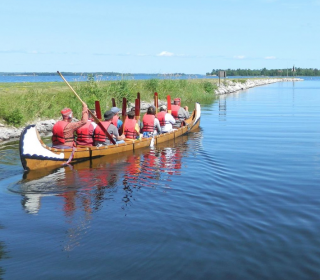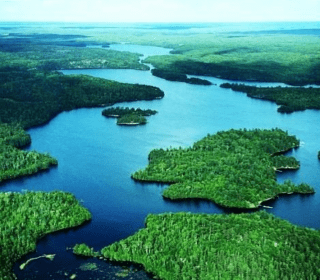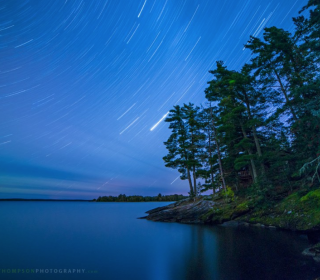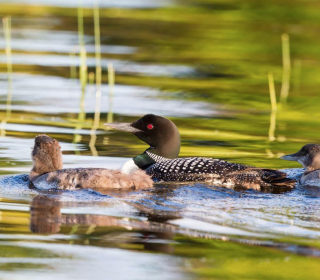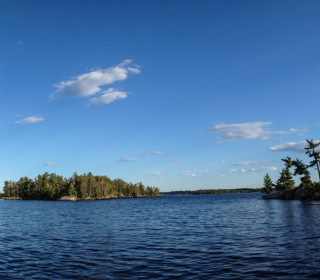 Park & Permit Info
Park & Permit Info
Entry into Voyageurs National Park is free. The park’s campsites–some of which are accessible by water only–may require fees and a permit. You can find additional details on park operations at the official Voyageurs website.
National Park Service Voyageurs National Park
Voyageurs National Park Association
 Fire Information
Fire Information
Campfires are allowed in the park. Consult the park website for special circumstances where high fire danger may limit campfire use. The Minnesota Department of Natural Resources also provides fire information for the area on its website. As always, visitors are encouraged to use gas or propane cook stoves to reduce impacts to the wilderness.
National Park Service: Voyageurs National Park
Minnesota DNR: Fire Information
 Maps & Routes
Maps & Routes
While the park provides an online overview map of the park, trip planning and navigation would be best served by more detailed maps produced by W. A. Fisher Maps and Publications and McKenzie Maps. Paddlers in Voyageurs generally gravitate toward the chain of “interior lakes” on the Kabetogama Peninsula, but Voyageurs is also a great place to enjoy some big water paddling on the historic voyageur route between Grand Portage and Lake Athabasca.
Some points of interest in the western region for planning a trip might include:
Little American Island (on Rainy Lake)
In the summer of 1893, gold was discovered on Little American Island, which led to the Rainy Lake Gold Rush. Today you can discover the past while exploring the remains of mining activities on the island, including a 210-foot shaft along with machinery and adits (horizontal entrances leading into mines). Little American Island is located just north and west of the Voyageurs National Park boundary on Rainy Lake.
Gold Portage and Hacksaw Pass day use site (Kabetogama Lake)
Gold Portage is a half-mile trail connecting Rainy Lake with Kabetogama Lake. Hikers, canoeists and kayakers can travel between the two lakes on this portage. The Kabetogama Lake end of the Gold Portage is an excellent place to begin an exploration of the west side of Kabetogama Lake. Visitors can picnic at the Hacksaw Pass day use site and explore Chief Woodenfrog’s Islands, both south of Gold Portage. Continue southwest to Tom Codd Bay to discover quiet, rocky wetlands and an abundance of wildlife.
Ellsworth Rock Gardens (Kabetogama Lake)
Imagine terraced flowerbeds and stone statuary in the midst of the wilderness. Jack Ellsworth, a Chicago contractor who spent summers on Kabetogama Lake from 1944 to 1965, created the Ellsworth Rock Gardens on a 60-foot granite outcrop. At its peak, the site grew to 62 flowerbeds with over 13,000 lilies blooming. As a visitor to the rock gardens today, you will see some of the original flowers Mr. Ellsworth planted along with the artistic stone sculptures.
Some points of interest in the central region for planning a trip might include:
Kettle Falls (Rainy Lake and Namakan Lake)
Kettle Falls has been a portage area as long as people have used the boundary lakes for travel. The falls were well known to American Indians, early fur traders, explorers, gold miners, commercial fishermen, and loggers who had to portage around this transportation barrier when traveling between Namakan and Rainy lakes. Hotel accommodations were established at Kettle Falls in the 1890s and exist today; the only lodging available in the park.
Some points of interest in the eastern region for planning a trip might include:
Grassy Bay Cliffs (Sand Point Lake)
Sheer granite cliffs rise 125 feet above the surface of Sand Point Lake and reach one of the highest points within Voyageurs National Park. Grassy Bay is an area rich in natural and cultural resources. The area provides examples of three reasons why the park was established: geologic features, outstanding scenery, and interconnected waterways. The bay and cliffs are accessible from Sand Point Lake on the far eastern edge of the park.
W. A. Fisher Maps
McKenzie Maps
Historic Kettle Falls Hotel
Voyageur Maps
Voyageurs Map at ShopCanoeing.com
 History
History
Voyageurs National Park was officially established on April 8, 1975. The area that makes up the park was first proposed as a national park in April 1891 by the Minnesota legislature. However, it wasn’t until nearly eighty years later, after protracted public and legislative conflict, that federal legislation authorizing the creation of the park was signed into law on January 8, 1971.
Voyageurs National Park gets its name from a past when French Voyageurs traveled the lakes and rivers of the “border route” between Grand Portage and Lake Athabasca, but the history of the park is even fuller and richer than that colorful era. Paleo-Indians first inhabited the area some 10,000 years ago. The park boasts more than 200 intact archaeological sites dating to European settlement. Logging, mining, and commercial fishing boomed in the area in the late-19th and early 20th centuries. The native forests of the area were coveted for their tall pines. The Little America gold mine started operation in the mid-1890s and spawned the town of Rainy Lake City. By 1898 the mine was closed and by 1906 Rainy Lake City was a ghost town. Commercial fishing boomed and faded at a less precipitous pace, but the long distances to market made profits less than desirable and the enterprise faded away.
Book: Voyageurs National Park: The Battle to Create Minnesota’s National Park
National Park Service: History & Culture
 Ecology
Ecology
Voyageurs National Park is either home or temporary host for a wide array of wildlife. The makeup of the population changes throughout the seasons, but of the many animals that might be observed in the aquatic and terrestrial upland habitats of the park, there are over 240 different species of birds, including bald eagles, loons, cormorants, hummingbirds, woodpeckers, osprey, white pelicans, and a myriad of songbirds; 42 species of mammals, including moose, black bears, gray wolves, white-tailed deer, lynx, beavers, river otters, and porcupines; 10 species of reptiles and amphibians, including snapping turtles, blue-spotted salamanders, wood frogs, and red-bellied snakes; and numerous invertebrates.
Situated on the southern portion of the Canadian Shield, Voyageurs National Park contains the most complete and extensive Pre-Cambrian geologic features in the United States. In fact, the rock formations in the park, many more than 2.5 billion years old, are some of the oldest exposed rock in the world. This region was born of underwater volcanic eruptions that created mountainous islands rising from a sea that does not exist today. Two million years of advancing and retreating glaciers eroded the land, scouring and sculpting an area that may have previously resembled the Great Plains. What was left behind was the water of melted glaciers and a barren, jumbled landscape of ancient bedrock, polished and marked by glacial striations.Browse our partner-sponsored Glasses, with a variety of options to suit every taste and budget, available to buy online
Eight thousand years ago much of the area that is Voyageurs National Park today may have been covered by Lake Agassiz, what is possibly the largest freshwater lake to have ever existed.
The plant life of Voyageurs National Park, like the landscape itself, is a demonstration of diversity and change. Vegetation in the park is primarily mixed forest. The park is located in an area called an ecotone, which is a transition area between different ecological communities containing species from both. At Voyageurs the shift is predominantly between deciduous northern hardwoods forest and conifer-dominated southern boreal forest, although the park’s array of ecosystem types includes fire-dependent forests, mesic hardwood forests, wet forests, peat-lands, fens, marshes, rocky outcrops, and lakeshore environments.
National Park Service: Voyageurs Nature & Science
 Fishing
Fishing
Voyageurs National Park provides excellent fishing opportunities throughout the year. The lakes are known to have over 50 different species of fish, including lake sturgeon, walleye, northern pike, black crappie, and smallmouth bass. Many believe these waters have some of the best walleye fishing in the country (if not the world) and some of the best smallmouth bass fishing in Minnesota. A Minnesota fishing license is required.
Minnesota DNR: Fishing
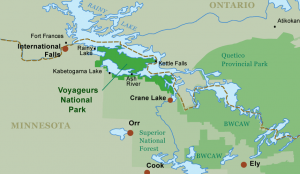 Explore Canoe Trip Services:
Explore Canoe Trip Services:


